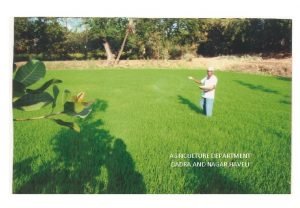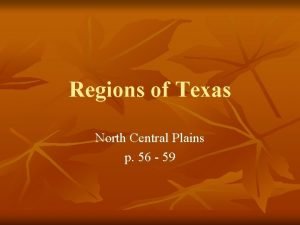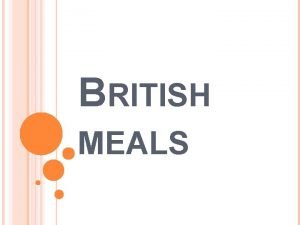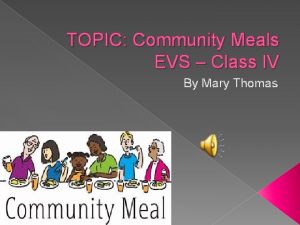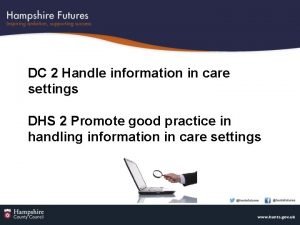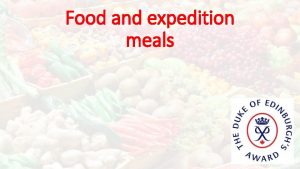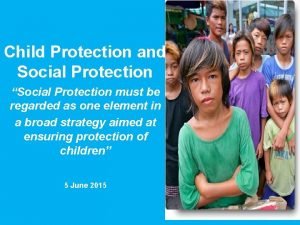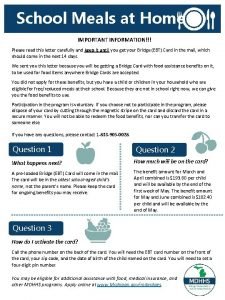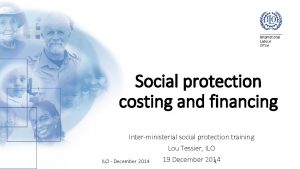Home Grown School Meals and Social Protection Using














- Slides: 14

Home Grown School Meals and Social Protection Using school meals as vehicle for improved nutrition Among Schoolchildren And Communities 29 th November 2017 Presented by Christine Hakonze

Presentation Objectives • To show Home Grown School Meals programme fits within national Social Protection Context • To share lessons from school meals programme as a nutritionsensitive intervention • To show benefits/successes of nutrition-sensitive school meals

School Meals Programmes are Global Priority • On all continents, governments and partners invest in feeding schoolchildren • Objectives include safety nets, agricultural development, nutrition, etc. • Models also differ- some programmes are sponsored by governments others by parents, non state actors or a combination of these • Food baskets also vary- from processed to unprocessed food, central procurement, localised procurement, canteens etc

HGSM is included among Key Social Safety Nets HGSM referenced in major National frameworks ü National Social Protection Policy (2014) ü 7 NDP (Education and community development) (20172021) ü National Food and Nutrition Strategy (2017 -2021) ü National Implementation Framework ü National Health Strategic Plan ü National Agricultural Investment Plan

MCDSS/ILO INTEGRATED FRAMEWORK (BASIC) SOCIAL PROTECTION PROGRAMMES GAP & COHERENCE ANALYSIS (2016) • HGSM identified as key SP programme for reaching school -going children • Suggestion to scale programme nationwide • Complete roll out of HGSM nationwide estimated to cost: − 617 M ZMW for Grades 1 -7 CONCEPTUAL FRAMEWORK 1: MULTIPLE VULNERABILITIES ACROSS THE LIFE CYCLE Reporting only programmes that are currently under implementation/with potential impact

Home grown School Meals Programme in Zambia: A brief historical Background • School meals were provided by government post independence, It was phased out in the 80 s due to national revenue decline • Re- started in 2003/2004 in drought affected district • Part of the national social protection framework • Piloting Fresh foods, MNPs, School gardens and nutrition education • 90% of food for school meals is grown and purchased locally • Nutrition is one of the key focus areas; innovative ways of improving nutrition content being explored

Why are School Meals Programmes important for nutrition? • Maternal education is strongly associated with improved nutritional status of her children (Bundy, 2011, Bhutta, et al, 2013) • Chronic undernutrition is associated with delayed school entry, early school termination, poor school performance, and reduced work capacity (USAID, 2014) • School feeding programmes can provide both nutritional menus and information on nutrition for the children • As part of school meals, gardens can be used for both learning about nutrition and acquiring practical agricultural skills

Link with Scaling Up Nutrition Project Objective 1. To promote the production and consumption of diverse, local, nutritious foods among targeted communities and schools 2. To bridge knowledge gaps on Nutrition 3. To generate lessons and best practices that will inform nutrition-sensitive policies and programmes 4. To increase rural households’ access to markets using the HGSM Programme PROJECT FACTS • Mumbwa • 7 schools • 75 Lead Farmers • 75 CHVs • 1600 PLW • 5700 school learners

Overview of project activities • Training of women groups • Maternal, infant and young child nutrition • Diversifying agricultural production and food processing • School model gardens • Nutrition education • Piloting local procurement of fresh vegetables

Nutrition education • Training of teachers • Class room teaching complements extra curricular nutrition activities • SHN clubs • Quizzes, Poems, Songs, Debates (interschool competitions)

Training of women groups Community Health Volunteers Exclusive breastfeeding Dietary diversity Complementary feeding Lead farmers Feeding a sick child Agricultural diversity Food processing Seed preservation

Successes • Increase in nutrition and gardening knowledge among schoolchildren • Vegetables supplement HGSM programme (variety!) • Gardens generate income for sustainability- and gives women chance to buy nutritional products they don’t grow • Increase in confidence, self esteem and research skills among pupils as they prepare and participate in competitions - quizzes, debates, poetry and songs • Children taking nutrition messages home and establishing vegetable gardens with their parents

Priorities Moving Forward • Develop and disseminate SHN training materials (NFNC/CDC and partners) for nutrition/SHN education • Roll out training of teachers in nutrition teaching; develop teaching materials • Strengthen school – community linkages – School As Centres of Excellence • Expand HGSF programme (geographically and with vegetables) • Establish school model demonstration gardens • Strengthen linkages between school, and the health and agriculture sector. • Advocate fortification of staples to benefit all children (and the rest of the population) • Establish direct linkage between the HGSM and other social protection interventions such as the Food Security Pack.

QUESTIONS? THANK YOU FOR YOUR ATTENTION For further details, please contact: Christine Hakonze Phone #: +260 971 040 411 Email: christine. hakonze@wfp. org
 Shade grown coffee vs sun grown
Shade grown coffee vs sun grown School meals north lanarkshire
School meals north lanarkshire All grown up and no place to go
All grown up and no place to go Irrigation projects in dadra & nagar haveli
Irrigation projects in dadra & nagar haveli My grown up christmas list link
My grown up christmas list link Maui grown coffee
Maui grown coffee North central plains landforms
North central plains landforms Father of english drama
Father of english drama Poetic techniques in the wild swans at coole
Poetic techniques in the wild swans at coole Obese fennec
Obese fennec Emperor tiberius grown
Emperor tiberius grown Balanced meals for breakfast lunch and dinner
Balanced meals for breakfast lunch and dinner Uk meal times
Uk meal times Community meal examples
Community meal examples Handle information in care settings
Handle information in care settings



